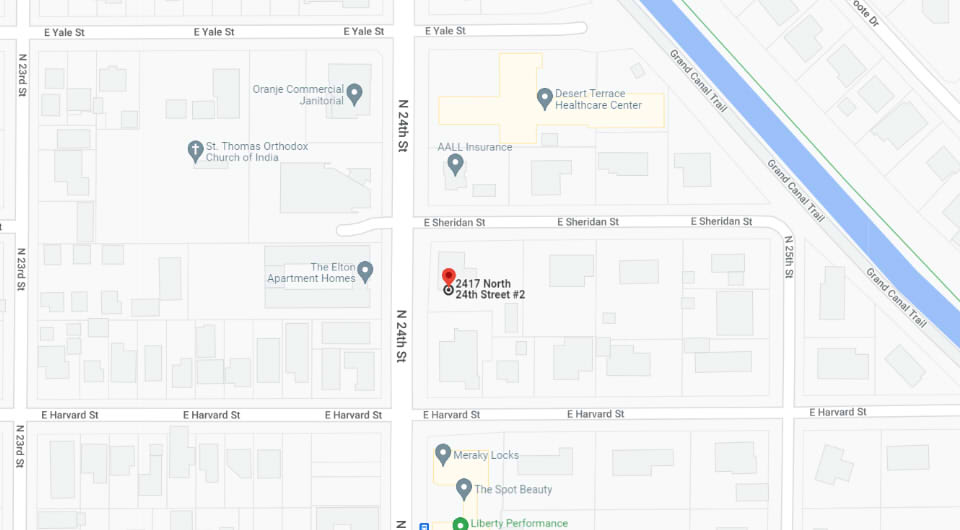It is not uncommon for a newborn’s bones to break during childbirth. However, in most cases, these injuries can be prevented. If your child sustained broken bones during childbirth, or in the moments following their birth, you could be eligible to seek compensation through a legal claim.
If your baby suffered a broken bone, our attorneys at Phoenix Personal Injury Attorney Law Firm can help you seek compensation from the liable medical facility or practitioner. We begin by offering a free case evaluation to determine whether medical malpractice led to the birth injury your child sustained. If so, we assist you in filing a claim and obtaining a fair settlement for you and your child.
Infant Broken Bones Lawsuits and Birth Injuries
Medical malpractice happens when a medical professional fails to offer an appropriate degree of care to their patient, who then sustains injuries that could have been avoided.
Broken bones in infants can occur for several reasons, including the doctor using excessive force during childbirth or failing to detect a condition that greatly raises the likelihood of fractures. When you sue someone for a birth injury, your lawyer can examine the details of the case and go over all of your available legal alternatives with you. You could be able to seek damages for:
- Medical expenses.
- Any expense paid out of pocket.
- Physical therapy.
- Suffering and pain.
To build a compelling argument, your birth injury lawyer will typically seek the assistance of various medical professionals to serve as expert witnesses. The witnesses can confirm that a standard of care was violated during the delivery process. A birth injury attorney can additionally gather more evidence to demonstrate the degree of your injuries and ensure that you obtain adequate compensation for you and your infant. This is important if you choose to pursue legal action.
Common Types of Bone Fractures During Childbirth
There are primarily two categories of fractures:
- Compound fractures.
- Simple fractures.
While the skin is broken in compound fractures, simple fractures involve the bones remaining under the skin. Most fractured bones in infants are just simple fractures. Additionally, there are several other categories of bone fractures. However, they are not all common in newborns. Among them are:
- Non-displaced single fractures.
- Buckle or torus fractures.
- Hairline or stress fractures.
- Compression fractures.
- Comminuted fractures.
- Greenstick fractures.
- Displaced fractures.
- Single fractures.
- Segmental fractures.
Greenstick fractures are among the most common types of bone breaks that occur in babies. They happen when the baby's bones are unusually fragile and so don't fracture in a similar manner that more developed bones do.
Common Bone Fractures in Infants
Natural childbirth techniques can sometimes lead to infant bone fractures. However, in a lot of cases, these injuries are the result of medical blunders that occurred during a complicated childbirth. The following list includes several common forms of infant broken bones:
Clavicle Fracture
Babies who are significantly larger than usual have an increased risk of having clavicle fractures during delivery. Clavicle fractures happen when newborns are stuck in the delivery canal. These injuries can also be caused by using vacuums or forceps during childbirth improperly or aggressively.
Humerus Fracture
A lack of arm mobility in a baby may be an indication that the child has sustained an injury to the humerus. A fracture of the humerus could happen if the doctor speeds through the delivery process. Rushing a delivery allows the newborn's head to pass through the delivery canal more easily, but causes problems for the baby's shoulders and neck.
Femur Fractures
A femur fracture, or broken thigh bones, is extremely unusual in infants and usually indicates a difficult birth. In contrast to other types of fractures, a femur fracture during labor has been linked to premature birth and low birth weight. In some cases, the chance of a fractured femur can be reduced by having a cesarean section, although the procedure is not without its risks.
Depressed Skull Fractures
The National Institutes of Health estimates that only four to ten births in every 10,000 result in depressed skull fractures. This injury is primarily associated with the incorrect use of equipment during labor and delivery and is uncommon in births that do not use instruments.
What are the Most Common Causes of Broken Bones in Newborns?
Even though the majority of medical professionals—nurses, doctors, and other healthcare practitioners—take immense care during labor and delivery, one careless move can result in severe, sometimes fatal injuries. The following are among the most typical reasons why infants suffer fractures:
- Prolonged labor.
- Failure to recognize and manage a breech birth properly.
- Rushed labor.
- Aggressive delivery methods.
- A newborn trapped behind its mother's pubis, commonly called shoulder dystocia.
- Incorrect utilization of delivery assistance like vacuums and forceps.
Fractures or breaks in bones can happen during delivery for a newborn with a genetic disorder that causes bone fragility. However, the leading cause of injuries of this nature is the utilization of too much force, such as tugging and pulling when attempting to move the newborn through the delivery canal.
Broken bones can occasionally form during a pregnancy, which raises the possibility of serious complications after delivery. In some cases, including when shoulder dystocia complicates childbirth, the doctor will apply pressure on the infant's head and hands to expel them out of the delivery canal. The doctor must be careful not to break the infant's bones while they pull.
In most cases, medical professionals can avoid unnecessary suffering of both mother and child by taking the following precautions during labor and delivery:
- Determine early in pregnancy if the child is at risk for developing weak bones.
- Keep a close eye on both the infant and its mother during the labor and delivery process.
- Make preparations to lessen the possibility of a challenging or drawn-out delivery.
To guarantee a safer birth, taking action involves planning for a cesarean delivery (C-section) or requesting an emergency cesarean. This is especially important if the newborn is unusually large or in case there is reason to suspect a cephalopelvic disproportion (CPD).
Injuries sustained during childbirth may result in legal and financial liability for the doctor or nurse who oversaw the birth. If you hire an expert medical malpractice attorney, they can assist you in pursuing the right compensation that you and your family deserve.
How To Recognize A Broken Or Fracture In Your Newborn
Fractures are the medical term for any broken bone, regardless of the severity of the break, which can range from a minor crack to a huge tear. Some signs of a bone fracture in a newborn include:
- Bones that seem misaligned.
- Sensitivity when touched.
- Visible swelling.
- Limbs bending at odd angles.
- Immobility in certain ligaments.
When your newborn has a fractured bone or fracture, it must be treated immediately. A visual examination, X-ray, MRI, or CT scan can be used to determine whether or not your infant has a broken bone. The medical staff can then identify what triggered your baby's bone fracture or break.
Thereafter, you'll be in a better position to assess whether or not your infant's injuries warrant a claim for birth injury compensation.
Diagnosis of Infant Broken Bones
The same methods that are used to diagnose fractured bones in adults are also used to diagnose fractured bones in newborns. These methods involve the use of medical imaging. The site of the fracture and the specific fracture type can be seen on an X-ray.
Doctors often diagnose newborn bone fractures in the following regions:
- The collarbone, or clavicle.
- The humerus.
- The femur.
Most newborn fractures just need a harness, cast, or splint to keep the bone secure while it recovers. However, more serious or dislocated breaks can need closed reduction, surgery, or traction.
The Treatment of Bone Fractures in Newborns
Sadly, there is not much that can be done about some common birth injuries like broken clavicles. Lifting the hurt infant should be done very carefully, and the injured shoulder may need to be immobilized, and that's as far as therapy goes.
Other injuries call for the setting of the bone or other treatments including surgery. Neck and back fractures are often regarded as the most dangerous of all fractures that can occur during birth. Injuries of this nature can cause chronic pain, permanent disfigurement, and even death in extreme cases.
Newborns who suffer from broken bones often also experience nerve damage. Damage to the nerves can result in paralysis and lost sensations, which can have lasting consequences. Birth fractures are common and could have catastrophic consequences due to damaged nerve networks called brachial plexus.
If your child suffers a broken bone or fracture while they are being born, you will want them to receive a diagnosis as soon as possible and make a swift recovery. The medical personnel will perform testing procedures that will enable them to evaluate the newborn's bones and decide the most appropriate course of treatment for them.
MRIs, X-rays, and CT scans are all examples of examinations that can be performed here. After determining the location and nature of the fractured bone, a physician could decide to immobilize your infant's bones with a cast or splint so that they can recover in the proper alignment. Your child might not need immobilization or a splint if they have a minor fracture.
Pursuing Compensation for Infant Broken Bones Due to Medical Malpractice
A birth injury attorney can assist you in filing a medical malpractice complaint to obtain compensation for your child's injuries if they were caused by the negligence of a medical practitioner or facility. To make sure you obtain reasonable compensation for your newborn's medical care, their pain, and any additional losses they sustained, your attorneys will guide you throughout the legal process.
An attorney who specializes in birth injury cases can help you determine who is responsible for your baby's broken bones. Several parties could be held responsible, including:
- The medical facility where your child was delivered.
- Medical specialists including anesthesiologists and lab technicians.
- The midwife, nurse, or doctor who helped with the delivery.
- Medical equipment producers.
- Pharmacists or pharmaceutical businesses.
Your attorney will then gather proof to show how the at-fault party's failure to follow safe medical procedures led to your newborn's injuries. Your attorney will use proof to support your case and seek restitution from the at-fault party or their insurance provider. Your attorney may choose to take the case to court when the responsible party does not agree to a settlement.
Damages You Can Recover in Your Medical Malpractice Claim
If your newborn baby has been injured due to negligence or medical malpractice on the part of your healthcare providers, you have the right to seek compensation for the losses that you have sustained. Your Phoenix birth injury attorneys will help you determine the value of your damages. Your attorney's level of experience in dealing with cases that are comparable to yours will determine how accurately they can assess your damages.
Your lawyer will take into account both your monetary and non-monetary losses in your birth-related injury case.
Economic Damages
To put it simply, economic losses are the financial losses you or your child have incurred. Below are some examples of the financial losses you could incur as a result of medical malpractice:
Lost Wages/Earning Potential
You can experience pay loss when the injuries that you or your child sustained as a result of the medical negligence incident require you to take some time off from work. You do have the ability to get back these losses.
If your child suffered a condition or injury that will prevent them from ever being financially independent, your lawyer may try to get you compensation for their lost potential for earnings.
Medical Bills and Costs
If you have been the victim of medical negligence, you may be entitled to compensation for all of the associated medical costs. Your Phoenix birth injury lawyer will determine the value of any future or additional medical care your infant may require as a result of their injuries.
If you want to help your lawyer out, it's a good idea to retain a medical journal that includes all of your baby's treatments.
Non-Economic Damages
losses you and your child have incurred that cannot be quantified in monetary terms are known as "non-economic losses." These include:
Suffering and Pain
Damages for "pain and suffering" are intended to recompense the infant for the pain as well as the emotional distress they have endured as a result of the incident that gave rise to legal action. This encompasses factors such as the possible loss of enjoyment in one's life.
An illustration of this is when your child suffers spinal cord damage that prevents them from using a bike or engaging in playground activities like other kids. Your lawyer will determine the monetary value of their pain and suffering.
Wrongful Death
Someone's wrongful death is the worst outcome that can happen in a medical negligence case. Dealing with fatal birth injuries or complications that result in the child's wrongful death is an awful experience, particularly if the damage would have been avoided. Taking legal action is within your rights as parents, and you can file a lawsuit for wrongful death against the at-fault medical provider.
Even while there is no sum of money that could ever make you feel better, it can offer you financial stability as you allow yourself the time to mourn and can help you get compensated for the psychological suffering and companionship loss you've endured.
During this trying time, your birth injury lawyer can answer any concerns you might have about filing a claim for wrongful death and can guide you throughout the process of filing a birth injury lawsuit.
What is the Statute of Limitations For Filing an Infant Broken Bones Claim?
Parents have a right to claim damages when their infant sustains an avoidable broken bone as a result of medical malpractice. However, there are dates you must meet, and those deadlines differ from state to state.
Further, the aggrieved individual could be subject to different regulations if they were a minor or the period of repose has already expired. It is therefore preferable to take on these kinds of lawsuits with the help of an experienced birth injury attorney on your side.
Your lawyer will analyze your case, advise you on the applicable statute of limitations, and ensure all necessary paperwork is filed promptly.
Can Broken Bones in Infants Be Fatal?
Most bone fractures in infants heal with little permanent damage and are not life-threatening. However, if your child is not properly diagnosed and treated early, the bone might not heal properly. It's called "malalignment," which can lead to permanent disfigurement and disability.
Find an Infant Broken Bones Attorney Near Me
Your final trimester of pregnancy should not be marked by anxiety over delivering a newborn with fractured bones or any other injuries. But if this were to happen to you, you have a right to know what caused your baby's injuries. And this is where the Phoenix Personal Injury Attorney Law Firm comes in.
Our medical malpractice and birth injuries attorneys are available to help you in recovering the financial compensation to treat your newborn's birth injuries. We will work diligently and help you find the liable parties that caused your baby's injuries. Call us today at 602-641-9589.










